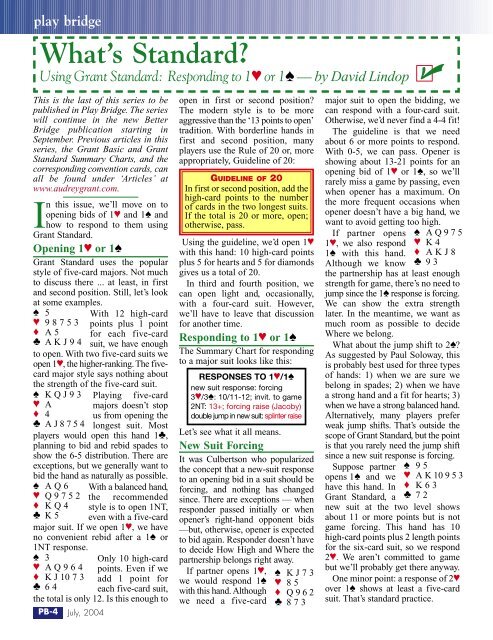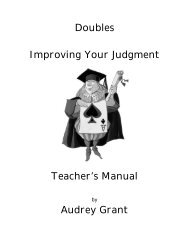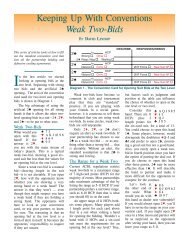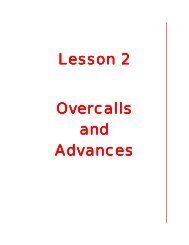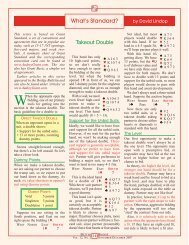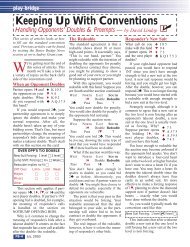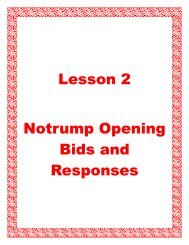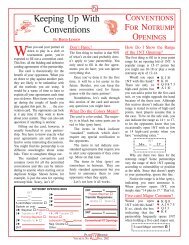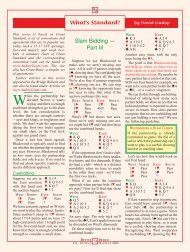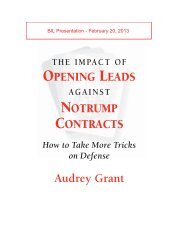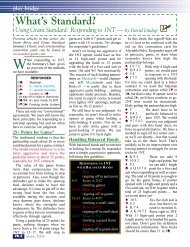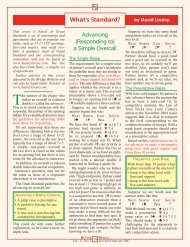Using Grant Standard - Better Bridge
Using Grant Standard - Better Bridge
Using Grant Standard - Better Bridge
Create successful ePaper yourself
Turn your PDF publications into a flip-book with our unique Google optimized e-Paper software.
play bridgeWhat’s <strong>Standard</strong>?<strong>Using</strong> <strong>Grant</strong> <strong>Standard</strong>: Responding to 1♥ or 1♠ — by David LindopThis is the last of this series to bepublished in Play <strong>Bridge</strong>. The serieswill continue in the new <strong>Better</strong><strong>Bridge</strong> publication starting inSeptember. Previous articles in thisseries, the <strong>Grant</strong> Basic and <strong>Grant</strong><strong>Standard</strong> Summary Charts, and thecorresponding convention cards, canall be found under ‘Articles’ atwww.audreygrant.com.In this issue, we’ll move on toopening bids of 1♥ and 1♠ andhow to respond to them using<strong>Grant</strong> <strong>Standard</strong>.Opening 1♥ or 1♠<strong>Grant</strong> <strong>Standard</strong> uses the popularstyle of five-card majors. Not muchto discuss there ... at least, in firstand second position. Still, let’s lookat some examples.♠ 5♥ 9 8 7 5 3♦ A 5With 12 high-cardpoints plus 1 pointfor each five-cardsuit, we have enough♣ A K J 9 4to open. With two five-card suits weopen 1♥, the higher-ranking. The fivecardmajor style says nothing aboutthe strength of the five-card suit.♠ K Q J 9 3♥ A♦ 4Playing five-cardmajors doesn’t stopus from opening thelongest suit. Most♣ A J 8 7 5 4players would open this hand 1♣,planning to bid and rebid spades toshow the 6-5 distribution. There areexceptions, but we generally want tobid the hand as naturally as possible.♠ A Q 6♥ Q 9 7 5 2♦ K Q 4With a balanced hand,the recommendedstyle is to open 1NT,even with a five-card♣ K 5major suit. If we open 1♥, we haveno convenient rebid after a 1♠ or1NT response.♠ 3Only 10 high-card♥ A Q 9 6 4 points. Even if we♦ K J 10 7 3 add 1 point for♣ 6 4 each five-card suit,the total is only 12. Is this enough toPB-4 July, 2004open in first or second position?The modern style is to be moreaggressive than the ‘13 points to open’tradition. With borderline hands infirst and second position, manyplayers use the Rule of 20 or, moreappropriately, Guideline of 20:GUIDELINE OF 20In first or second position, add thehigh-card points to the numberof cards in the two longest suits.If the total is 20 or more, open;otherwise, pass.<strong>Using</strong> the guideline, we’d open 1♥with this hand: 10 high-card pointsplus 5 for hearts and 5 for diamondsgives us a total of 20.In third and fourth position, wecan open light and, occasionally,with a four-card suit. However,we’ll have to leave that discussionfor another time.Responding to 1♥ or 1♠The Summary Chart for respondingto a major suit looks like this:RESPONSES TO 1♥/1♠new suit response: forcing3♥/3♠: 10/11-12; invit. to game2NT: 13+; forcing raise (Jacoby)double jump in new suit: splinter raiseLet’s see what it all means.New Suit ForcingIt was Culbertson who popularizedthe concept that a new-suit responseto an opening bid in a suit should beforcing, and nothing has changedsince. There are exceptions — whenresponder passed initially or whenopener’s right-hand opponent bids—but, otherwise, opener is expectedto bid again. Responder doesn’t haveto decide How High and Where thepartnership belongs right away.If partner opens 1♥,we would respond 1♠with this hand. Althoughwe need a five-card♠ K J 7 3♥ 8 5♦ Q 9 6 2♣ 8 7 3major suit to open the bidding, wecan respond with a four-card suit.Otherwise, we’d never find a 4-4 fit!The guideline is that we needabout 6 or more points to respond.With 0-5, we can pass. Opener isshowing about 13-21 points for anopening bid of 1♥ or 1♠, so we’llrarely miss a game by passing, evenwhen opener has a maximum. Onthe more frequent occasions whenopener doesn’t have a big hand, wewant to avoid getting too high.If partner opens1♥, we also respond1♠ with this hand.Although we know♣ 9 3the partnership has at least enoughstrength for game, there’s no need tojump since the 1♠ response is forcing.We can show the extra strengthlater. In the meantime, we want asmuch room as possible to decideWhere we belong.What about the jump shift to 2♠?As suggested by Paul Soloway, thisis probably best used for three typesof hands: 1) when we are sure webelong in spades; 2) when we havea strong hand and a fit for hearts; 3)when we have a strong balanced hand.Alternatively, many players preferweak jump shifts. That’s outside thescope of <strong>Grant</strong> <strong>Standard</strong>, but the pointis that you rarely need the jump shiftsince a new suit response is forcing.Suppose partneropens 1♠ and wehave this hand. In<strong>Grant</strong> <strong>Standard</strong>, a♠ A Q 9 7 5♥ K 4♦ A K J 8♠ 9 5♥ A K 10 9 5 3♦ K 6 3♣ 7 2new suit at the two level showsabout 11 or more points but is notgame forcing. This hand has 10high-card points plus 2 length pointsfor the six-card suit, so we respond2♥. We aren’t committed to gamebut we’ll probably get there anyway.One minor point: a response of 2♥over 1♠ shows at least a five-cardsuit. That’s standard practice.
Requiring about 11 or more pointsto respond in a new suit at the twolevel means we follow the standardpractice of occasionally responding1♠ over 1♥ when we have a longerminor. For example, we respond 1♠over 1♥ with thishand because wedon’t have enoughstrength to bid 2♦.The Simple RaiseAlthough it isn’t mentioned on thechart — or the Convention Card forthat matter — it’s assumed we makea simple raise of opener’s major tothe two level with three-card orlonger support and about 6-10 points.Some authorities use 6-9 points asthe guideline for raising to the twolevel, but most players♠ Q 6 2would raise 1♥ or 1♠ to♥ Q 9 4the two level with this 10-♦ K J 7 3point hand. The queens♣ Q 9 4and balanced distribution don’t makeit worth bidding more.A raise to the two level typicallyshows three- or four-card support.With this hand, wewould raise 1♥ to 2♥ or1♠ to 2♠. There areonly 5 high-card♠ Q 9 7 3♥ 7♦ A J 8 7 5♣ 9 7 3♠ Q 9 6 5♥ Q J 7 3♦ 6 2♣ 10 8 5points, but it’s common practice toreplace length points with dummypoints when raising partner’s major.DUMMY POINTSVoid=5; singleton=3; doubleton=1OOPS!In the May issue, Come to the Partyhad an incorrect caption on this photo.Lillian Shaman is the player on the left.Emmy Lou Cahn is the player on theright.Limit RaisesMost partnerships use the jumpraise of opener’s major as a limit —invitational — raise, promising fourcardsupport and about 11-12points, or a good 10.If partner opens 1♠,we would jump to 3♠with this hand. Thereare 8 high-card points♣ K 9 6 2and we can add 3 dummy points forthe singleton heart. The jump raiseis invitational. Opener can pass witha minimum opening bid or continueto game with a little extra.It’s usually best to have four-cardsupport for a limit raise. With threecardsupport, start with a new suit.If partner opens 1♠,we respond 2♣ withthis hand, planningto show the spade♠ Q 9 8 3♥ 4♦ K 9 7 2♠ K 6 4♥ 7 3♦ Q 9 4♣ A J 8 5 3support at the next opportunity. Theadvantage of this approach is thatopener will be better placed todecide whether to continue to gameknowing whether we have threecardor four-card support.Jacoby 2NTExtending the concept that a raise tothe two level shows 6-10 points and ajump to the three level shows 11-12,it would seem reasonable that a raiseto the four level would show 13 ormore. However, it’s become standardpractice to use a jump raise to the fourlevel as a preemptive bid, typicallyshowing a weak hand with five-cardor longer support. If ♠ 7 4partner opens 1♥, ♥ K 10 7 5 3we would jump to ♦ 54♥ with this hand. ♣ J 10 7 4 2Also, a jump to the four leveltakes away a lot of bidding room. Itbecomes difficult for opener toexplore slam possibilities withoutrisking getting too high. So, thepopular style is to use a jump to2NT in response to 1♥ or 1♠ as anartificial forcing raise — the Jacoby2NT convention.JACOBY 2NT OVER 1♥/1♠• four-card or longer support• 13 or more pointsUnless the partnership has someother agreement, Jacoby 2NT nolonger applies if responder is apassed hand or if there is a doubleor an overcall by responder’s righthandopponent.If partner opens 1♠,we would respond 2NTwith this hand. Thereare 12 high-card pointsplay bridgeplus 1 dummy point for the doubletonheart. We are willing to commit thepartnership to at least game afterpartner opens 1♠.Is there an upper limit to thestrength for the 2NT response? Somepartnerships prefer to limit thestrength to about 16-17 points. With astronger hand, responder starts with ajump shift, as discussed earlier.Replying to Jacoby 2NTThe big advantage of Jacoby 2NT isthat it immediately sets the trumpsuit and leaves plenty of room toexplore for slam without risking gettingbeyond the game level. Afterthe 2NT response, opener describesthe distribution and strength of theopening hand as follows:♠ A J 8 6 3♥ 5♦ K J 9 4For example, if weopen 1♠ with thishand and partnerresponds 2NT, we♣ K 7 6rebid 3♥ to show a singleton or voidin hearts. This doesn’t promise anyextra strength. The next move is upto responder.How responder uses this informationwill have to be left for anothertime and place (see PB-12).Vol. 8, No. 7♠ K 10 7 3♥ A 4♦ 9 6 2♣ K Q 7 5OPENER’S REBIDWith shortness:• a new suit at the three levelshows a singleton or void.• a jump to the four level in anew suit shows a good fivecardside suit.With no shortness;• a jump to game in the majorshows a minimum opening.• 3NT shows a mediumstrengthhand.• a rebid of the major at thethree level shows a maximumPB-5


